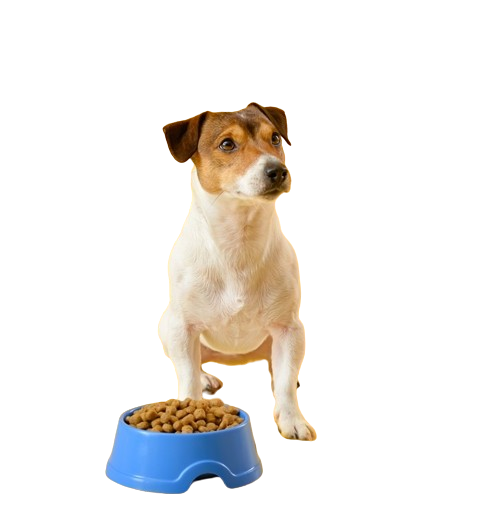Key Takeaways:
- Understanding your dog’s nutritional needs is crucial for their overall health.
- Factors such as age, breed size, and activity level influence the amount of food your dog requires.
- Properly reading and interpreting dog food labels is essential for providing the right nutrients.
- Calculating your dog’s daily caloric needs helps in maintaining a healthy diet.
- Overfeeding and underfeeding can lead to health issues, so it’s important to be mindful of portion sizes.
I. Introduction
Imagine your dog staring at you with those soulful eyes. Is their rumbling tummy asking for more food or a quick walk? Knowing how much to feed your dog is important for their health and happiness.
Too little food, and your pup might not have the energy they need. Too much, and they could gain weight, which can lead to health problems down the road.
Don’t worry – figuring out the ideal portion size isn’t as complicated as it seems! Let’s dive in and discover the best way to feed your furry friend.
II. The Basics: Factors Affecting Your Dog’s Ideal Meal Size
Think about it: a tiny Chihuahua and a giant Great Dane clearly won’t need the same amount of food! Here’s what matters when deciding how much to feed your dog:
- Age: Puppies need extra calories and nutrients for their growing bodies. Senior dogs often need less food as their metabolism slows down.
- Breed: Small breeds have faster metabolisms than larger breeds, meaning they might need more frequent meals.
- Activity Level: A dog who spends all day running at the park burns more calories than one who loves naps.
- Individual Needs: Some dogs are just naturally hungrier or prone to weight gain. Medical conditions can also affect how much your dog should eat.
Reading Serving Recommendations
Understanding the suggested serving sizes on dog food labels is crucial. These recommendations are tailored to your dog’s size and weight.
Table: Key Nutrients in Dog Food
| Nutrient | Purpose |
|---|---|
| Protein | Essential for muscle and tissue repair |
| Fat | Provides a concentrated source of energy |
| Carbohydrate | Offers a source of sustained energy |
III. Deciphering Dog Food Labels
The feeding guide on the back of a dog food bag is a good starting point, but it’s not the whole story. Here’s why:
- One Size Doesn’t Fit All: Those guidelines are based on averages. Your dog might need more or less food depending on the factors we discussed earlier.
- Understanding the Lingo: Terms like “calorie density” and “guaranteed analysis” can be confusing. Let’s break them down in simple terms.
- Treats Matter: Remember those yummy snacks? They count towards your dog’s daily food intake! Ignoring this can lead to overfeeding.
IV. How to Figure Out the Right Amount of Food
Getting your dog’s portions right is key. Here’s how to do it:
- Your Vet is Your Best Friend: Always start by getting your veterinarian’s advice. They know your dog’s health history and can give tailored recommendations.
- Body Condition Score: Learn to assess your dog’s body shape. Are they too thin, overweight, or just right? A simple chart or a vet demonstration can teach you how.
- Calorie Calculators: Many websites offer calorie calculators for dogs. These tools take into account your dog’s weight, age, and activity level to suggest a portion size. Here is the best calorie calculator I found
| Signs of Overfeeding | Signs of Underfeeding |
|---|---|
| Weight gain | Lethargy |
| Reduced activity levels | Dull coat |
| Digestive issues (vomiting) | Visible ribs or spine |
V. Adjusting Portions: Beyond the Basics
The right food amount for your dog isn’t set in stone – it can change! Here are some common situations where you might need to tweak the portions:
- Lifecycle Changes: Puppies need more food as they grow, while senior dogs often need less.
- Neutering/Spaying: These procedures can alter a dog’s metabolism, sometimes meaning a change in food quantity is needed.
- Switching Foods: Always introduce a new food gradually over a week or two. This helps avoid tummy upset and lets you adjust portion sizes if new food has a different calorie content.
- Seasonal Changes: If your dog spends lots of time outdoors, they may need more food during colder months to stay warm.
VI. Troubleshooting: When to Worry About Your Dog’s Eating Habits
Most of the time, minor variations in your dog’s appetite are normal. However, sometimes changes in eating habits can point to something more serious. Here’s when to pay attention:
- Sudden Changes in Appetite: If your dog usually gobbles down their food but suddenly turns away, or a picky eater starts scarfing everything down, it could signal a problem.
- Unexplained Weight Fluctuations: Weight loss or gain without a change in food or exercise routine could be a sign of a health issue like parasites, thyroid problems, or even stress.
- The Picky Eater: If your dog has always been finicky, there are tricks to get them the nutrition they need. But, sudden pickiness could mean something is wrong.
Important Note: If something seems off about your dog’s eating behavior or weight, don’t hesitate to make an appointment with your vet.
Allergies and Sensitivities
Understanding and addressing food allergies and sensitivities is paramount. For a detailed exploration, check AKC – Can Dogs Have Food Allergies?.
| Medical Condition | Recommended Diet |
|---|---|
| Diabetes | High-fiber, low-carb diet |
| Joint Issues | Food rich in omega-3 fatty acids |
| Food Allergies | Limited-ingredient, hypoallergenic diet |
VIII. FAQs: Your Top Questions Answered
- How often should I feed my dog?
Most adult dogs do well with two meals a day. Puppies usually need smaller, more frequent feedings. Your vet can give the best advice. - Is it better to free-feed my dog?
For most dogs, scheduled meals are better. This helps prevent overeating and makes housetraining easier. - My dog is always hungry. Is something wrong?
Some dogs are simply food-motivated! But if your dog’s appetite drastically changes, check with your vet to rule out any medical problems. - How do I know if I am feeding my dog the right type of food?
Look for a high-quality food formulated for your dog’s life stage. Talk to your vet if you need help choosing the best brand. - Can I add human food to my dog’s diet?
Occasional safe treats are okay, but dog food should be the main source of nutrition. Many human foods are unhealthy or even dangerous for dogs!
VII. Conclusion
Figuring out how much to feed your dog doesn’t have to be a puzzle! Remember these key points:
- Every Dog is Different: Age, size, activity level, and even individual quirks all play a role in determining the right amount of food for your dog.
- You Can Do This! By learning to assess your dog’s body condition and seeking guidance from your vet, you can confidently meet their nutritional needs.
- Your Vet is Your Partner: Never hesitate to reach out to your veterinarian with questions or concerns. They’re there to help you keep your furry friend happy and healthy.









